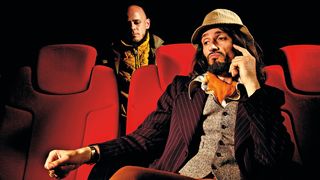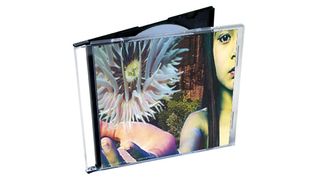After having a dancefloor smash like the seminal Papua New Guinea, most producers would swiftly follow up with more of the same. Not The Future Sound of London. After their early '90s club classic kicked open the doors of the dance music industry, they quickly shot inside, boarded them up, and began creating a new strain of electronic music a world away from the friendly grooves of their standout hit.
Papua New Guinea was their Trojan horse, and it gave them all the space they needed behind enemy lines to plan their next exploration into sound.
"When we signed to Virgin, we literally had all the power," says FSOL mouthpiece, Garry Cobain, "I don't think they really understood it. They viewed [signing us] as their incursion into this new demographic of dance music. Of course, we got there courtesy of Papua New Guinea. Our plans via that track were just, 'Fuck the pop, let's go deep now'. Papua was us gaining the power, and we used it on Lifeforms."
Gone was the three hit singles format - there were no radio-friendly dispatches here as lead salvos regularly bothered the 40-minute mark.
Gone were the star guests - on the beat-less Cerebral, for instance, vocals from Curve's Toni Halliday are whittled down into textures and snippets.
Gone was the urgency for dancefloor acceptance - this was listening music. It was anti-chart, and fresher than 99% of the charts because of it.
Lifeforms was, and still is, a complicated and rewarding journey into sound, with no interest in anything as obvious as a verse/chorus arrangement. Still, it rose to number six in the UK album charts on release - the same week Seal sat at the top spot. The former Adamski vocalist turned his back on underground music for a shot at mainstream success, yet FSOL gained theirs by being anything but.
"It was like, 'How great would it be, amongst all this plastic shite, to have a great album?'" says Cobain. "It seemed to us that people, like us, would be really open to that.
"Why were they there? Was it drugs? Post-club chillout? They were ready, and we knew that, so didn't want to waste the opportunity of just going into sound."
Here, Garry Cobain takes us track by track through his and bandmate Brian Dougan's seminal work…
Cascade
"The six-minute album version of Cascade is so different to the 40-minute single. We saw it as a great opportunity to write another album, but based around one song.
"It wasn't just our idea - The Orb had recently done Blue Room as a 40-minute single. It was great to see these new 40-minute albums appear in the singles charts at £1.99 rather than three minutes of pop… Unfortunately, Gallup changed the rules shortly thereafter in response."
Ill Flower
"We'd made two full versions of the album before we scrapped it and began making Lifeforms. They were failed attempts, really. We were being influenced by fun, bumpy Balearic stuff, and there were basslines that were moving in that way - if they had appeared on the album it would have absolutely destroyed it.
"We knew we could put 4/4s all over it, but we didn't want to make it recognisable to a very receptive market. We looked down at everybody who played that card. Ultimately, we tried to do something that was alien and timeless."
Flak
"We sampled Ozric Tentacles on this track. In those days you'd send a letter with a copy of the sample and the track on a cassette, then a month later you'd get a reply. They said, 'Just have it, but can you buy us a copy of Cubase?' It seemed like there was support from the artist community across the generations. What a lovely, spirited understanding for what we were trying to do."
"The album was made during a time of great revolutions in sampling, before the lawyers came in and made it solely about copyright and generating further income."
Bird Wings
"The album was made during a time of great revolutions in sampling, before the lawyers came in and made it solely about copyright and generating further income.
"Brian is revolutionary in terms of his sound and what he can twist, and my forte is the need to express feelings and to concentrate on interaction between the sounds. Within ambience, I could bring in all this absolute epic beauty in terms of the melody."
Dead Skin Cells
"Dead Skin Cells was the sound of two guys rotting away in a studio they never cleaned. It was literally the room of dead skin cells.
"The track names weren't fanciful names of escapism, and that's what was interesting about them. This was reality. Buggy G Riphead, our art collaborator, used to call it Ultra Reality. We loved that. It was a hyper reality. We always wanted to see reality exposed as a different state."
Lifeforms
"For the 40-minute single, Liz Fraser did ten amazing versions, almost completely improvised on the spot. We hope to release the full results.
"Around '91 the drugs were wearing off, metaphorically and literally, and these twats who'd never been into good music in the first place suddenly went, 'What the fuck am I doing on a dancefloor?' Having everyone's appreciation seemed less important now. Our attitude was, 'I don't give a fuck if you don't like Lifeforms. It's a miracle you even liked Papua New Guinea'."
Eggshell
"Nice samples in this one. Around the time, we were living around Old Street in London, and all the back streets had a rich heritage of secondhand markets. This was a great period, pre-internet, for finding music via secondhand record stores. Vinyl was really alive. Not just for new vinyl, but for finding old stuff and educating yourself. We found a lot of great samples in these stores."
Among Myselves
"This was about the rationalisation of our own schizophrenia. We wanted to use music to become better people and find our many selves. I don't think you have any better opportunity than being a musician to find out who you are. That's why I've always liked musicians, even if I don't like their music - they've got a certain spirit."
Domain
"DJs had an illness. To be honest it seemed like everyone had an illness except us, especially within Dance music. The music on Lifeforms became a reaction against that.
"We had DJs coming up to us saying the music on the album was rubbish. They liked Papua New Guinea because it was a dancefloor smash. We weren't interested in that anymore. We just wanted to make really unusual music."
Spineless Jelly
"The music papers didn't know how to talk about what we were doing. We were more punk or rock 'n' roll than these bands with the right haircut but nothing to say. We could see that and said it in interviews. Looking back at those interviews now, I look very angry and over the top, but we did it to make a point. This was no escapist chillout music made by academics; we were vibrant dynamic upstarts wanting a sonic revolution!"

Interstat
"It was a lonely place making this kind of music. It wasn't about a band, or being in a club. It was two guys, almost meditating on sound, forming their own rules in near isolation.
"We had a record deal, yes, but we also had this enormous pressure on our shoulders to make an album that would recoup the money invested in us, which ultimately meant it had to be a commercial success however noble our art pretensions."
Vertical Pig
"People were starting to get into ambience, but it was all pretty and escapist. We called it 'dolphin music', courtesy of the fact everyone seemed to throw in dolphin mating sounds.
"The music we liked was a mix of romance and harshness, so what evolved in the studio was a kind of euphoric sadness. We combined found, organic sounds with sample modification, triggering, pitching and splicing. Together, it amounted to something disorientating, but strangely familiar and emotional."
"The music we liked was a mix of romance and harshness, so what evolved in the studio was a kind of euphoric sadness."
Cerebral
"Toni Halliday of Curve was involved here. We took her vocal and reduced it to snippets. She's credited with 'Texture' on the album. We probably didn't like the song she gave us. I guess Brian and I were so heavily into deep and powerful songs that until we hooked up with Liz Fraser of the Cocteau Twins we felt nothing was evoking that intensity we loved, so we always needed to mystify the vocal by further sampling and producing it."
Life Form Ends
"Talvin Singh performs on here. After Papua New Guinea, there was a lot of what we dubbed 'ethno-trip-hop'. It was the birth of people like Transglobal Underground. Real World Records invited us to work with musicians like Nusrat Fateh Ali Khan. I'd have loved to work with them, but we turned that down. As much as I liked what those people were doing, it wasn't for us; it seemed too obvious."
Vit
"It was such a revolutionary period for music back then. It's the only time I can recall when instrumental music has had that power. Everyone was obsessing about all the sonics - how deep the bass was, how trippy it was, how much it flipped you out. People were going out and bashing their heads in various metaphorical ways. I was proud to be part of that."
Omnipresence
"We were just two guys who were brothers in sound. We used to have this running gag of challenging people and journalists with our sonic telepathy. We'd say that if you put us in separate rooms in different parts of the world and played us sounds, we would pick the same samples we liked to form a palette of sounds. We resonated on the same sounds, and still do today; it freaks people out!"
Room 208
"We would have about 200-300 sounds pulled together to form our sonic palette. It's hard work moulding and sculpting that many samples as they'd be taken from the TV, records, DAT, microphones, or from abusing musicians. We'd get them in, pay them 50 quid and tell them to play like Miles Davis in his experimental phase for half an hour, and we'd leave the tape running and go out."
Elaborate Burn
"Right now we are making this process mental and verbal, but there was no mental or verbal involved in making the album. It was all about activating a feeling… once we'd triggered it once, it was like a drug twisting sounds each time to activate similar feelings we couldn't articulate. It was two guys, almost with their eyes closed, responding to sound."
Little Brother
"We were living a very dedicated life to sound, and immersed in finding this thing that was going to freak everybody and ourselves out, and ultimately resonate and produce this great moment. Everyone was going off the mantra, 'One nation under a groove'. They believed the bodily gathering would save them, back to a second summer of love vibe. In fact, our situation was the opposite - our music was based on isolation. In that reality we found out that the sampler was a microscope on our lives."





